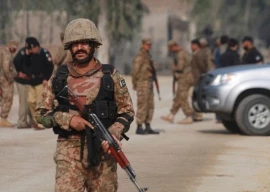This was very much in evidence recently, when an Indian convicted of spying and jailed in Pakistan for over two decades, was released. His name was Surjeet Singh and it was close enough to that of another Indian prisoner, convicted of terrorism and also in a Pakistani jail, Sarabjeet Singh. The problem arose when most television channels reported, quoting an unnamed source, that President Asif Ali Zardari had ordered the release of Sarbajeet Singh. The response in India was immediate because it had been lobbying for his release since long and this then turned sour when it turned out it was not Sarabjeet but Surjeet Singh who was being released.
The matter was clarified around six to eight hours later, after the presidential spokesman, Farhatullah Babar, said that the person who was being released was not Sarabjeet but Surjeet Singh. He also said that he was being released because he had served out his term of life imprisonment and that he could not be held in prison any longer. The belated reaction from Pakistani officials had an adverse impact on the Indian side, which has now demanded that Sarabjeet Singh also be released. Sarabjeet is on death row, convicted of involvement in bomb blasts in Lahore and Faisalabad.
What one saw was that rather then get direct quotes from the officials of the ministries concerned, the media was more interested in getting reactions from various political parties and from Sarabjeet Singh’s family. In 2009, a joint committee of media owners, editors, journalists and the government had, in a report, observed that a journalist must try and obtain more than one source for verification of news. There is no doubt that the reliance of the media, in this case, on an unnamed source, along with a considerable delay on the part of the government ended up complicating matters.
We do not seem to be exhibiting the tendency of learning from our mistakes and instead we usually try and put the entire blame on officialdom, usually the government.
It all started with three red tickers in various television channels, all titled ‘Breaking news’ and all quoting unnamed source. The first said that the president had commuted the death sentence of Sarabjeet Singh to life imprisonment. The second said that the president had ordered the release of Sarabjeet Singh and a third that the law ministry had sent a letter to the interior ministry to start the process of releasing the prisoner. There were some follow-up tickers and all of them were either about the background of the case or on reactions from Sarbajit’s family.
I have not gone through India’s print and electronic media to see whether they merely picked up the news or did some of their own investigation — given the way news from Pakistan is covered in India and vice versa, it is likely that they just showed whatever the channels in Pakistan were reporting.
The coverage should shame the media in Pakistan into enforcing certain minimum professional standards for those who work in it. Also, the media must learn to offer an apology if it has done something wrong and this was a case when it should have done precisely that.
Published in The Express Tribune, July 6th, 2012.
COMMENTS (9)
Comments are moderated and generally will be posted if they are on-topic and not abusive.
For more information, please see our Comments FAQ

















Mazhar Abbas, you are rights, dear the media should find facts and must not believe the unnamed sources.....and this suggestion of yours apply to journos of both sides India and Pakistan. I feel civil society of Pakistan will show sympathetic approach and help in doing justice with Sarbjeet Singh......
regards !
Perhaps the confusion was due to the fact that their names are similar, as well as the fact that they look like brothers.
It is always best to name and shame the journalists responsible for substandard or inaccurate reporting - they then tend to be less keen to repeat their unprofessional behaviour.
This is lame excuse offered by the author on the u-turn Pakistan authorities made under pressure from hardliners. It was indeed Sarabjeet who was to be released. It is hard to believe that the Pakistan foreign office was in hibernation and came alive post midnight like a nocturnal creature to issue clarifications. No one in the right mind is buying this story.
Garbage in garbage out! That's most of our media, government services, political parties and armed services, in a nutshell.
at the moment there are few listeners in media circle , but good job mr mazhar. sanity will prevail in the end , i strongly believe.
and while at it mazhar, please use your position to ban showing the body parts of victims. it is not humane.
Bravo Mazhar. Welcome to this great paper.